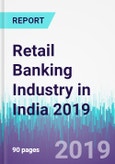The retail banking sector, currently comprises a network of ~96,068 branches of public sector, private sector, foreign, regional, rural, and cooperative banks (urban and rural). During the
FY 2014-FY 2019 period, deposit at SCBs expanded at a compound annual growth rate (CAGR) of ~10.39% to reach INR 1,30,430.12 Bn in FY 2019 from its FY 2014 value of INR 79,556.90 Bn.
Various government initiatives like increasing the number of banks’ public service units in rural areas, the Pradhan Mantri Jan Dhan Yojana program, free credit and debit cards with low transaction limits and promotion of technology-based banking systems are driving the growth of the retail banking sector of India.
Major players operating in the Indian retail banking industry include Yes Bank Limited, Axis Bank Limited, Bandhan Bank Limited, State Bank of India Limited and HDFC Bank Limited.
Market Segment Insights
As of FY 2018, in terms of deposit, public sector banks held the highest market share (~70.06%), followed by private sector banks. In FY 2018, SCBs opened around 1,594 new branches in tier I cities across India, which accounts for ~40.37% of the overall new branches opened during the year. During the same period, public sector banks had around 82,730 on-site ATMs and about 63,234 off-site ATMs across India. Among these, most public sector bank ATMs are in the semi-urban regions.
Key growth drivers of the market
In order to increase the penetration of services across India, SCBs have introduced facilities like opening a zero-balance savings account for the low-income population group in rural areas. Government-led, bank-based pension and insurance schemes like Pradhan Mantri Suraksha Bima Yojana, Pradhan Mantri Jeevan Jyoti Bima Yojana and Atal Pension Yojana have also propelled the growth of the retail banking industry in India.
Owing such customer-centric facilities, the penetration level of the banking sector in India had reached ~80% in FY 2018. The introduction of internet-based banking facilities has made transactions easier, thereby increasing the account-to-account transaction volume across the country.
Key deterrents to the growth of the market
Apart from banking, the popularity of internet-based banking has made it easy for hackers to engage in fraudulent activities. Crimes related to credit card fraud, spamming, spoofing, e-money laundering, ATM fraud, phishing, identity theft and credit through unauthorized cheque increased in India in FY 2019, as compared to that of FY 2018. This, in turn, has led to customers’ dissatisfaction and loss of trust towards web-based banking.
Companies covered
FY 2014-FY 2019 period, deposit at SCBs expanded at a compound annual growth rate (CAGR) of ~10.39% to reach INR 1,30,430.12 Bn in FY 2019 from its FY 2014 value of INR 79,556.90 Bn.
Various government initiatives like increasing the number of banks’ public service units in rural areas, the Pradhan Mantri Jan Dhan Yojana program, free credit and debit cards with low transaction limits and promotion of technology-based banking systems are driving the growth of the retail banking sector of India.
Major players operating in the Indian retail banking industry include Yes Bank Limited, Axis Bank Limited, Bandhan Bank Limited, State Bank of India Limited and HDFC Bank Limited.
Market Segment Insights
As of FY 2018, in terms of deposit, public sector banks held the highest market share (~70.06%), followed by private sector banks. In FY 2018, SCBs opened around 1,594 new branches in tier I cities across India, which accounts for ~40.37% of the overall new branches opened during the year. During the same period, public sector banks had around 82,730 on-site ATMs and about 63,234 off-site ATMs across India. Among these, most public sector bank ATMs are in the semi-urban regions.
Key growth drivers of the market
In order to increase the penetration of services across India, SCBs have introduced facilities like opening a zero-balance savings account for the low-income population group in rural areas. Government-led, bank-based pension and insurance schemes like Pradhan Mantri Suraksha Bima Yojana, Pradhan Mantri Jeevan Jyoti Bima Yojana and Atal Pension Yojana have also propelled the growth of the retail banking industry in India.
Owing such customer-centric facilities, the penetration level of the banking sector in India had reached ~80% in FY 2018. The introduction of internet-based banking facilities has made transactions easier, thereby increasing the account-to-account transaction volume across the country.
Key deterrents to the growth of the market
Apart from banking, the popularity of internet-based banking has made it easy for hackers to engage in fraudulent activities. Crimes related to credit card fraud, spamming, spoofing, e-money laundering, ATM fraud, phishing, identity theft and credit through unauthorized cheque increased in India in FY 2019, as compared to that of FY 2018. This, in turn, has led to customers’ dissatisfaction and loss of trust towards web-based banking.
Companies covered
- Allahabad Bank Limited
- Axis Bank Limited
- Bandhan Bank Limited
- Bank of Baroda Limited
- HDFC Bank Limited
- ICICI Bank Limited
- Kotak Mahindra Bank Limited
- RBL Bank Limited
- State Bank of India Limited
- Yes Bank Limited
Table of Contents
Chapter 1: Executive summaryChapter 2: Socio-economic indicatorsNote: Similar information covered for other companies on best effort basis.
Chapter 3: Introduction
Chapter 4: Market overview
Chapter 5: Key performance indicators
Chapter 6: Competitive benchmarking
6.2. Axis Bank
Chapter 7: Development strategies adopted
Chapter 9: Competitive landscape
Note: Similar information covered for all other public companies. Private companies' data given on best effort basis.
Chapter 10: Appendix
Companies Mentioned
- Allahabad Bank Limited
- Axis Bank Limited
- Bandhan Bank Limited
- Bank of Baroda Limited
- HDFC Bank Limited
- ICICI Bank Limited
- Kotak Mahindra Bank Limited
- Ratnakar Bank
- State Bank of India Limited
- Yes Bank Limited
Methodology

LOADING...








